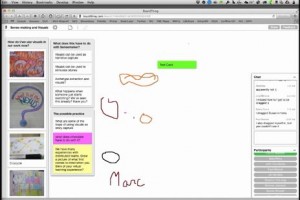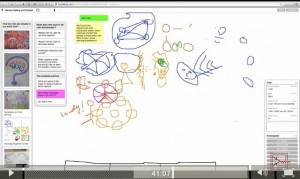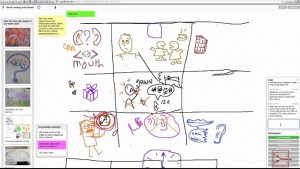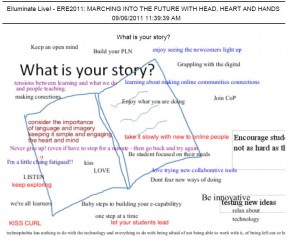What follows is a mish-mashed report on an online event from December 2014. I know better than to procrastinate this long…
Last month Laurie Webster invited me to do a web gathering with her as part of a free series she has been offering. She is a pro with all sorts of quantitative processes and particularly the use of Sense-Maker ®. I like the way she thinks/does and she was totally open to a wild-hair experiment. I was not offering to share what I KNOW, I wanted to think together about what is tickling my brain.
Our pitch was simple: come play and think out loud with us.
Join me and Nancy for a fast-paced event that promises to be both practical and playful. Nancy will begin by describing how she uses visual methods in a variety of facilitative settings. Then we will discuss how these methods can both supplement and complement sensemaking and the use of SenseMaker®. The real fun will begin when registrants are invited to join Nancy in the sandbox for a real-time, “safe-to-fail” experiment using a shared online drawing tool.
Her clever partner, Stephen DeLong came up with the most imaginative title, Sensemaking + Graphic Facilitation > The Sum of its Arts. I bow down to this cleverness, and it well expresses the idea that Laurie and I had been wondering about: what is the role of visuals in the sensemaking process.
We started by introducing our fields – graphic facilitation, and sensemaking. Of course, I was being a goofball as usual. This is deliberate. Low status body language with high status verbal language = people listen differently. They can’t quite pin things down from past experience, so they are open. Thank you, Viv McWaters! That insight you shared a few years back at the Applied Improvisation conference has borne much fruit!
I’m a huge fan of graphic recording and graphic facilitation. Visuals are powerful tools. By that I mean all those wonderful things like pictures can initiate great conversations, they aren’t so explicit that we can assume we understand so we ask each other questions, “tell me the story” here, etc. Visuals are openers.
At the same time I have become increasingly troubled when I sense that MY drawing is actually taking sensemaking agency away from the people I’m supporting. My drawing, as hard as I try to be a faithful, neutral reporter, still carries my interpretation. It is what I hear and how I make sense of that. Sometimes my interpretation and synthesis can be useful. But when the drawing (or other visual approaches such as photo cards, collage, Draw With Me, etc.) is in the hands of everyone, we can both take advantage of the power of visuals, and disintermediate the sensemaking. Tracy Kelly picked up on this topic and posted a very thoughtful blog post on “Graphic Recording: how to disintermediate.” Do hop over and read it!
Combine this with the work that Laurie and her colleagues have been doing with sensemaking through the use of narrative fragments, we start getting some interesting “science fair experiments.” We started wondering out loud if people can draw their narrative fragments and if we could apply sensemaking processes to those visual fragments.
The jumping off point is we have to be comfortable drawing our silly little stick figure pictures. Oh, how repressed we are about drawing in public. So we dumped everyone into a drawing environment. No hiding!
The real fun started at about 30 minutes in. You can see a video of the whole process here, but you must register and log in. There is a 1 minute teaser for those of you who don’t want to register. (I understand!) We left the “webinar” environment and moved to BoardThing, a wonderful invention of Dave Gray and friends. We accidentally erased all the drawing we did, but I’ll share a few screenshots below. I wanted to not just TALK about participant-generated visuals, but to DO them.
First we introduced some of the functionality of Boardthing, which is a wonderful mash up of online card sorting, a shared whiteboard and a chat room. (The chat of the event is attached for your reading pleasure. ChatFromDecVizSensemakingWebinar ) We did a wee bit of card sorting (on the left of the screen shots). Then I invited a group of 9 people to start drawing on the whiteboard. We then debriefed from both the drawers’ and observers’ perspective. If you peek at the transcript, you will see that this first round was not particularly comfortable for those drawing, and a bit hard to make sense of by the observers. Then I sketched in a grid and gave a second, more focused drawing prompt. The images came faster and were easier to use to engage in the sensemaking process. We then chatted about the power of constraints!
The hour flew by and we did not come to any momentous insights, but based on page views of the video and followup emails Laurie has received, I think we hit on something resonant. I’m not sure what to do with it next, but I plan to think/play/experiment some more. There is some distance to travel between the whole “getting people drawing” thing, and the more sophisticated sensemaking processes. My main conclusion is that using the drawings helps prevent people from prematurely coming to interpretations and conclusions. There is sufficient ambiguity to stimulate us to learn more and dive deeper, and sufficient novelty to shake us out of our “thinking ruts.” That’s good stuff. The question now is how to apply these insights usefully. For sure, it will be fun.
Finally, Susan Stewart recently started a Facebook group about webinars and reflected a bit on the process. She said it was OK to share here!
Susan Stewart’s reflections
Just finished the webinar with Nancy White … she’s such a willing risk-taker. (We used two platforms: GoToWebinar and BoardThing (in Beta) – BoardThing for drawing together.) Many take-aways from the webinar, I will share two and I hope others who participated will share some, too!
1. TRY DRAWING: I have used white boards for things like having folks write their thoughts, plot the intersection of their previous learning experiences and their comfort with current content, dragging their name to a chair as a way of taking role and letting them claim a space in the conversation (Thanks, LaDonna Coy!)… I have not invited folks to draw…but I think I will try giving them a prompt and some instruction on how to use the tools, then invite observations by those not drawing and also by those who have done the drawing.
Interestingly, this is not about high quality art, but about iconic scrawls. Even the most rudimentary images can represent some profound understandings.
Nancy noted that drawing sometimes allows things to emerge that otherwise might not have – even the drawer may not be cognizant of what is coming forth until it is there. She did share that this can be quite powerful and suggests setting up the situation with much thought and being prepared with how to respond if strong emotions are triggered.
I think we had 47 people on the webinar from all over the world. Nancy, what is your take on the level of engagement by all participants…those drawing, those commenting and those observing? (That last group is hard to assess.) I know we had two groups of about 9 each drawing.
2. TAKE RISKS: Nancy made a comfortable environment for us to explore in. She took risks with us and was willing to deal with surprises. That spoke volumes to me about how important it is in online meetings and participatory webinars to step away from the presentation and allow time and room for mucking about together with the participants.
My experience in learning about online meetings and webinars has been mostly about exploring and risk taking. That’s one of the reasons I started this group. I learned by getting in the sandbox with others and trying things out. I’m glad that Nancy invited us into her sandbox today and I hope you’ll feel comfortable asking us to take risks with you. I feel confident that as a group we will continue to find ways to engage with participants that are creative and meaningful.
The invitation to the sandbox is open!







